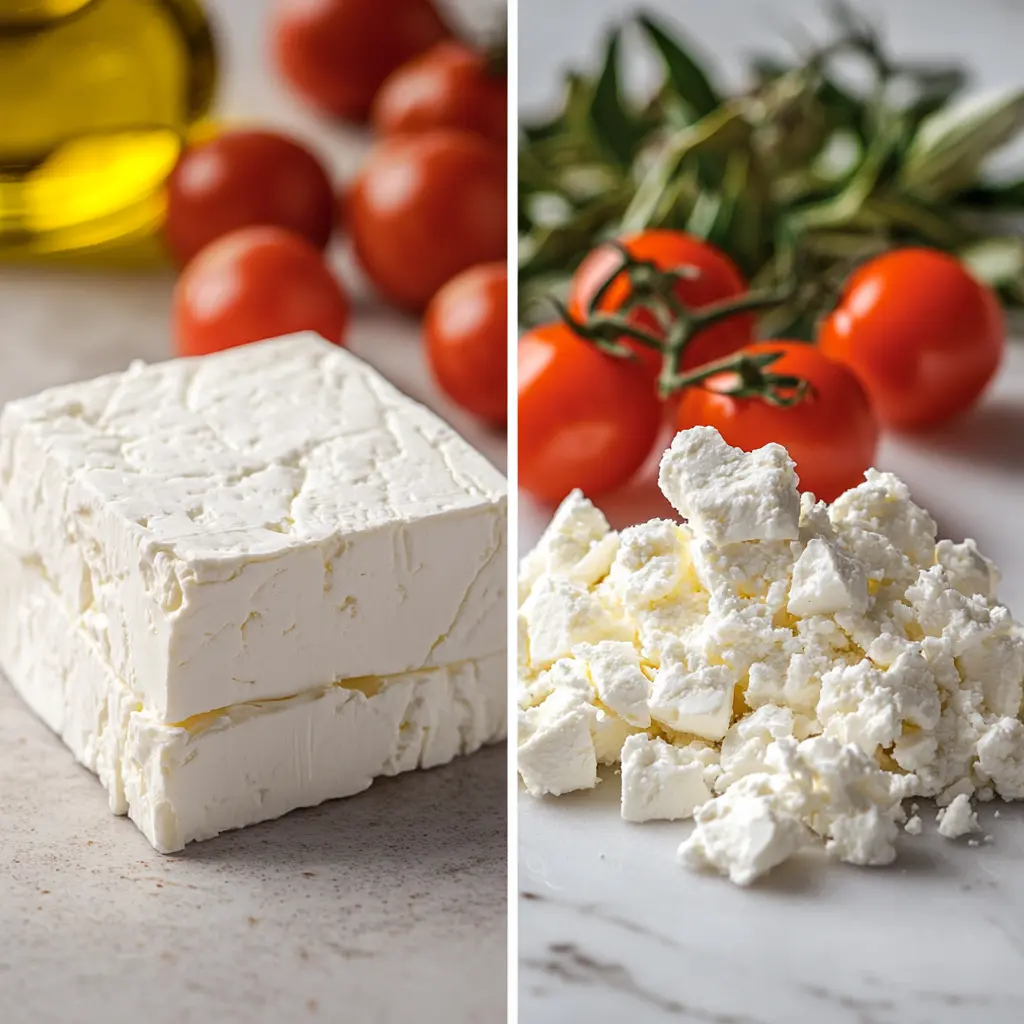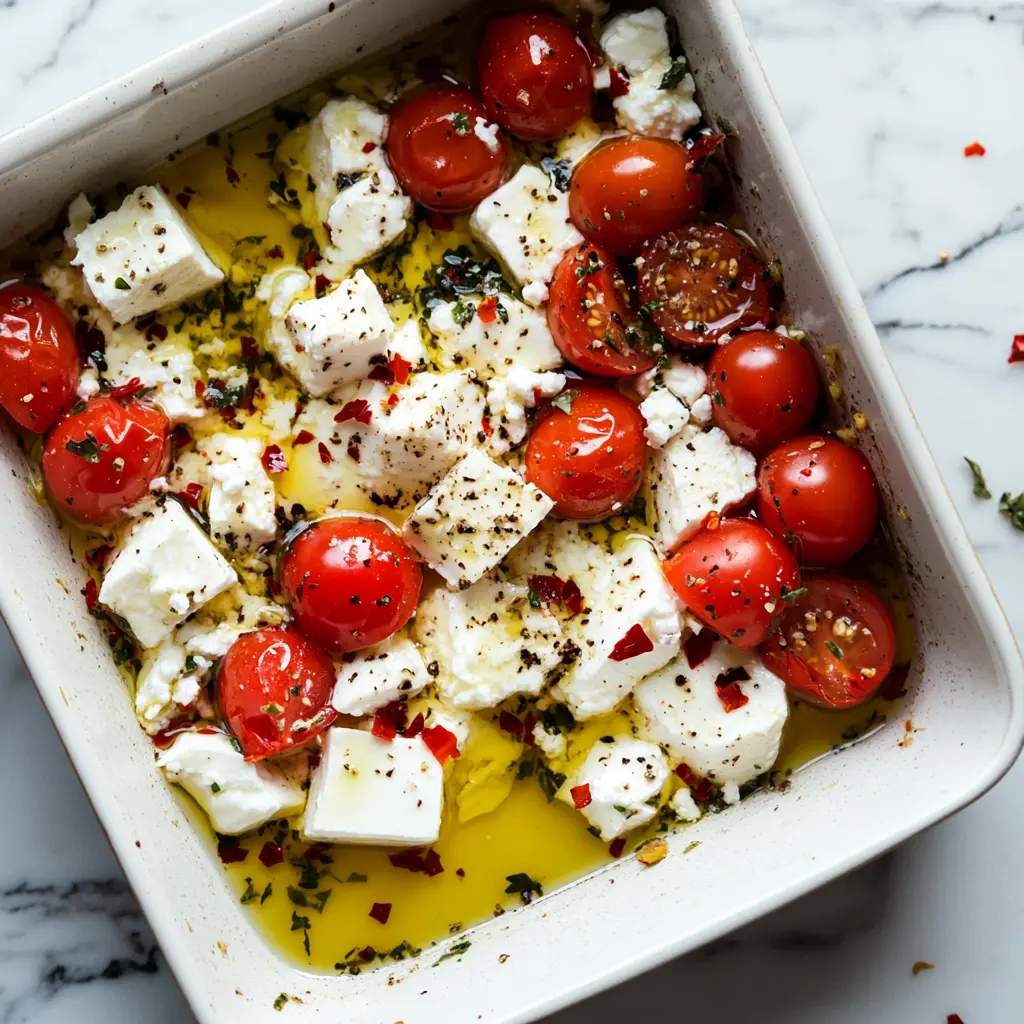Introduction
Baked feta pasta has become a global phenomenon, celebrated for its creamy texture, bold flavors, and simplicity. Traditionally made with a block of feta cheese, this dish combines tangy feta, roasted tomatoes, and pasta to create a rich and satisfying meal. However, one common question arises: Can you use crumbled feta for baked feta pasta? https://royalesrecipes.com/easy-baked-feta-pasta-recipe/
Crumbled feta is more readily available and often more affordable than block feta. But does it deliver the same creamy, melt-in-your-mouth experience that the original recipe promises? In this guide, we’ll explore whether crumbled feta works as a substitute, the key differences between block and crumbled feta, and tips for using it effectively in baked feta pasta. Whether you’re curious about convenience or taste, this article has all the answers you need.
The Difference Between Block and Crumbled Feta

1. Texture
- Block Feta: Typically packed in brine, block feta has a moist, smooth texture that softens beautifully when baked.
- Crumbled Feta: Pre-crumbled feta is often drier, as it lacks the brine that helps preserve its moisture.
2. Flavor
- Block Feta: Maintains a rich, tangy flavor with a creamy consistency that stands out in baked recipes.
- Crumbled Feta: Slightly milder and less tangy due to additives that prevent clumping.
3. Additives
- Crumbled feta often contains anti-caking agents, which can affect how it melts or combines with other ingredients when baked.
4. Availability and Cost
- Crumbled Feta: More widely available in grocery stores and often more budget-friendly.
- Block Feta: Preferred for recipes that require smooth textures but may be less convenient for quick meals.
Can You Use Crumbled Feta for Baked Feta Pasta?
The Short Answer
Yes, you can use crumbled feta for baked feta pasta, but the results may differ slightly in texture and creaminess compared to using block feta.
How Crumbled Feta Performs in Baking
1. Melting Ability
- Crumbled feta does not soften as smoothly as block feta when baked.
- Instead of forming a creamy base, it may retain some of its crumbly texture, requiring additional steps to create a cohesive sauce.
2. Flavor Intensity
- The slightly milder taste of crumbled feta might make the dish less tangy. This can be balanced with seasonings like lemon juice, garlic, or red pepper flakes.
3. Sauce Consistency
- Without the moisture of block feta, crumbled feta may result in a less creamy sauce. Adding a splash of olive oil or cream can help achieve the desired consistency.
Tips for Using Crumbled Feta in Baked Feta Pasta
If block feta isn’t available or you prefer to use crumbled feta, here’s how to make the most of it:
1. Combine with Liquid
- Add a few tablespoons of olive oil or milk to the crumbled feta before baking to enhance its creaminess.
- Alternatively, mix the feta with heavy cream to create a smoother texture.
2. Use High-Quality Crumbled Feta
- Opt for crumbled feta made from sheep’s or goat’s milk for a richer flavor and softer texture. Avoid ultra-processed varieties.
3. Increase the Baking Time Slightly
- Since crumbled feta is drier, bake it for an additional 5–10 minutes to help it soften. Monitor closely to prevent burning.
4. Blend the Sauce
- After baking, use a fork or immersion blender to mash or blend the feta and tomatoes into a cohesive sauce.
5. Balance the Flavors
- Add fresh basil, lemon zest, or a drizzle of honey after baking to compensate for the milder flavor of crumbled feta.
Step-by-Step Recipe Using Crumbled Feta

Ingredients:
- 1½ cups crumbled feta
- 2 cups cherry or grape tomatoes
- ⅓ cup extra virgin olive oil
- 3 cloves garlic, minced
- ½ teaspoon red pepper flakes (optional)
- 10 ounces pasta (e.g., penne or fusilli)
- Fresh basil for garnish
Instructions:
- Preheat the Oven: Set the oven to 400°F (200°C).
- Prepare the Baking Dish: Add cherry tomatoes, olive oil, minced garlic, and red pepper flakes to a baking dish. Toss to coat.
- Add the Feta: Sprinkle crumbled feta evenly over the tomatoes. Drizzle with a little more olive oil.
- Bake: Place the dish in the oven and bake for 35–40 minutes, stirring halfway through to ensure even roasting.
- Cook the Pasta: While the feta and tomatoes bake, cook the pasta according to package instructions. Reserve ½ cup of pasta water.
- Combine: After baking, mash the feta and tomatoes together with a fork. Add the cooked pasta and reserved pasta water, stirring until the sauce coats the pasta evenly.
- Garnish and Serve: Top with fresh basil and serve immediately.
Advantages and Drawbacks of Using Crumbled Feta
Advantages of Using Crumbled Feta in Baked Feta Pasta
While crumbled feta isn’t the traditional choice for baked feta pasta, it offers several practical advantages that make it an appealing option for many home cooks. Here’s a closer look at why crumbled feta might work well for this dish:
1. Convenience
- Why It’s Helpful: Crumbled feta is pre-prepared and ready to use straight from the package, saving you the time and effort of cutting or crumbling a block of feta yourself. This can be particularly beneficial for those looking to whip up a quick meal without additional prep work.
- Impact: With crumbled feta, you can streamline the cooking process and focus on other aspects of the recipe, like seasoning or side dish preparation.
2. Wide Availability
- Why It’s Helpful: Crumbled feta is more commonly found in grocery stores than block feta. It’s also sold in various sizes, allowing you to purchase exactly the amount you need for a specific recipe.
- Impact: If you’re in a hurry or unable to find block feta, crumbled feta offers a convenient and accessible alternative. This makes it easier for home cooks to try baked feta pasta without worrying about sourcing specific ingredients.
3. Cost-Effectiveness
- Why It’s Helpful: Crumbled feta is often less expensive than block feta, especially when purchased in larger quantities. This can make it a budget-friendly option for families or individuals cooking on a tight budget.
- Impact: By opting for crumbled feta, you can enjoy the flavors of baked feta pasta without overspending on specialty ingredients. This makes the dish more accessible to a broader audience.
4. Perfect for Other Dishes
- Why It’s Helpful: Crumbled feta’s versatility extends beyond baked feta pasta. If you have leftovers, you can easily use them in salads, omelets, grain bowls, or as a topping for soups and pizzas.
- Impact: Choosing crumbled feta allows you to repurpose the cheese for other recipes, reducing waste and enhancing meal variety.
5. Easier Portion Control
- Why It’s Helpful: Pre-crumbled feta makes it simpler to measure exact amounts for recipes, ensuring you don’t use too much or too little cheese. This is particularly useful if you’re scaling a recipe up or down.
- Impact: With crumbled feta, you can achieve precise portions and balance the flavor of your dish more effectively.
6. Great for Quick Adjustments
- Why It’s Helpful: Since crumbled feta is already broken down into smaller pieces, it can be evenly distributed throughout the dish or combined with other ingredients more quickly. This makes it easier to tweak flavors or textures mid-recipe.
- Impact: If you’re experimenting with seasonings or adding other elements like cream or olive oil, crumbled feta allows for smoother adjustments during cooking.
By recognizing these advantages, it’s clear that crumbled feta has its own unique benefits that make it a practical alternative for baked feta pasta. While it may require some adjustments to match the texture and flavor of block feta, its convenience, affordability, and versatility make it an excellent option for busy cooks or those seeking a simpler approach.
Drawbacks:

While crumbled feta can work as a substitute for block feta, it comes with a few notable drawbacks that can affect the outcome of your baked feta pasta. Here’s a deeper look at the potential challenges and how they might influence the dish.https://www.gimmesomeoven.com/baked-feta-pasta/
1. Less Creamy Texture
- Issue: Crumbled feta is drier and less cohesive compared to block feta, which is often packed in brine. This dryness prevents it from softening and blending into a creamy sauce as effectively during baking.
- Impact: Instead of forming the luscious, velvety texture typically associated with baked feta pasta, crumbled feta may leave you with a grainier consistency.
- Solution: Add extra olive oil, cream, or pasta water after baking to compensate for the lack of creaminess.
2. Weaker Flavor
- Issue: Pre-crumbled feta tends to have a milder taste than block feta, partly because it’s often made from cow’s milk rather than the traditional blend of sheep and goat’s milk. Additionally, it’s usually drained of the brine that enhances its tangy, savory flavor.
- Impact: The final dish might lack the bold, tangy profile that makes baked feta pasta so distinctive.
- Solution: Boost the flavor by adding garlic, lemon zest, or spices like red pepper flakes and smoked paprika. Using high-quality crumbled feta made from sheep or goat’s milk can also help.
3. Additives in Crumbled Feta
- Issue: Crumbled feta often contains anti-caking agents like cellulose or starch to prevent clumping. These additives can affect how the cheese behaves during cooking, potentially inhibiting its ability to soften and blend smoothly.
- Impact: The texture of the sauce may be less uniform, and the dish could lose some of the richness that block feta naturally provides.
- Solution: Choose brands of crumbled feta with minimal additives, or mix the cheese with a bit of olive oil or cream to improve its consistency before baking.
4. Less Versatility
- Issue: The pre-crumbled nature of the cheese limits its versatility. For recipes like baked feta pasta, a single block of feta acts as the visual and culinary centerpiece, whereas crumbled feta lacks that same appeal.
- Impact: The presentation may look less polished, and the dish might not achieve the same visual allure as the original version.
- Solution: Even with crumbled feta, you can achieve a better appearance by arranging the cheese in a single layer and baking it alongside the tomatoes for even roasting.
5. Requires Extra Effort
- Issue: Because crumbled feta doesn’t naturally melt and soften as easily as block feta, you’ll likely need to take additional steps to achieve the desired texture and flavor.
- Impact: This extra effort can make crumbled feta less appealing for those who value the simplicity of the original recipe.
- Solution: Be prepared to mash the feta thoroughly after baking and adjust the sauce with liquids like reserved pasta water or cream to achieve the right consistency.
6. Potential for Overcooking
- Issue: The smaller pieces of crumbled feta are more exposed to direct heat during baking, increasing the risk of overcooking. Overbaked feta can become too dry and lose its ability to form a cohesive sauce.
- Impact: Overcooked crumbled feta may result in a dish that feels dry and lacks the creamy richness expected in baked feta pasta.
- Solution: Reduce the baking time slightly (by 5–10 minutes) or cover the dish with aluminum foil during the first half of baking to prevent over-drying.
By understanding these drawbacks, you can anticipate and mitigate potential challenges when using crumbled feta for baked feta pasta. While it may not replicate the exact results of block feta, with a few adjustments, crumbled feta can still deliver a flavorful and satisfying dish.
FAQs About Using Crumbled Feta in Baked Feta Pasta
1. Does crumbled feta melt the same way as block feta?
No. Crumbled feta doesn’t melt as smoothly as block feta due to its drier texture and added anti-caking agents. However, combining it with olive oil or cream can improve its consistency.
2. Can I substitute crumbled feta directly in any baked feta recipe?
Yes, but you may need to adjust the baking time and add liquid to compensate for the drier texture of crumbled feta.
3. Is crumbled feta made from the same ingredients as block feta?
Crumbled feta is typically made from the same base ingredients (sheep, goat, or cow’s milk), but it often lacks the brine that keeps block feta moist and tangy.
4. How can I enhance the flavor of crumbled feta?
Add fresh herbs, garlic, lemon zest, or spices like smoked paprika to amplify the dish’s flavor profile.
5. Can I use crumbled feta in other baked dishes?
Yes, crumbled feta works well in casseroles, stuffed vegetables, or as a topping for baked potatoes or flatbreads.
Conclusion
While block feta remains the gold standard for baked feta pasta, crumbled feta can be a viable substitute with some adjustments. Its convenience and availability make it a practical option for home cooks, but achieving the creamy texture and bold flavor of the traditional recipe requires a few extra steps.
By adding liquid, enhancing the flavors, and blending the sauce after baking, you can create a dish that’s just as satisfying. Whether you’re using crumbled feta out of preference or necessity, this guide ensures your baked feta pasta turns out delicious every time.
Now that you have the tools and tips, it’s time to grab your ingredients and try this customizable take on the viral sensation. Happy cooking!

